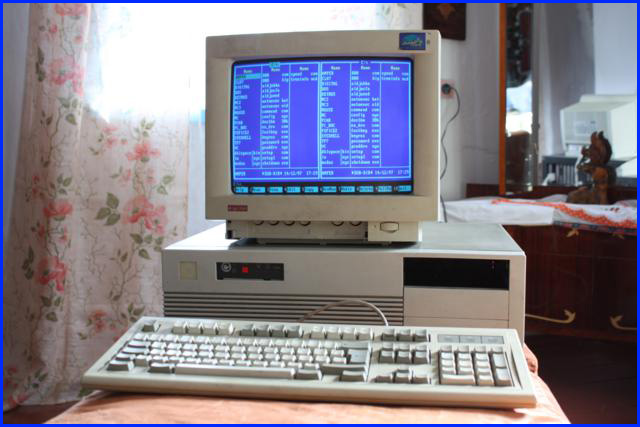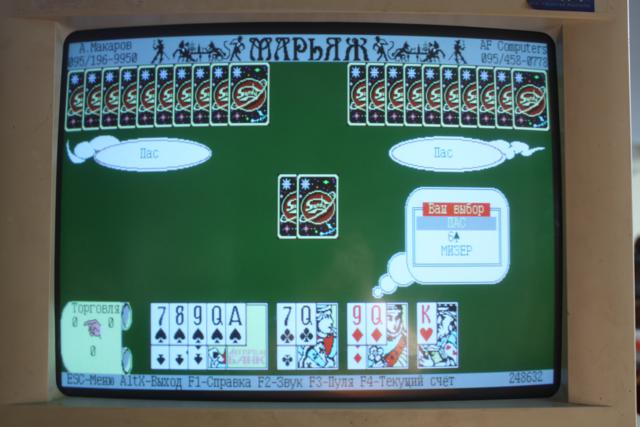Old but still working 286
The weekend came and finally I managed to go and take some pictures of what I promised.
Description and pictures - under the cut. (Caution - traffic!)
So what is this machine:
- Processor - 80286 12MHz
- 1MB RAM
- HDD - 2x20 MB
- Steel case with a wall thickness of about 2mm
This computer was assembled by my father. I don’t remember, however, what year it was, but I remember how he played “Maryazh”, how relatives came to us who studied somewhere in universities, and did some tasks, I remember the rustling of floppy disks in the drive. Accordingly, my brother and I began to gradually join in this kind of technique. In the end, this influenced my and his choice of profession.
And here is the review itself:

This is how it looks from the outside:

Next we arm ourselves with a screwdriver, open the case, and we see ... a bunch of dust, a shell from seeds, and wires bitten by mice. As a result, after some cleaning, everything takes the following form: Now you can sort it out a bit. First, all expansion cards are pulled out. Without them, the motherboard looks like this: The longest board is the Floppy / HDD controller WD1003-WA2 ( there is about it in Google ): This machine has 2 ST225 hard drives of 20 MB each, when there was still a drive for five-inch floppy disks, but then was pulled out and installed on a more modern computer to read a bunch of floppy disks (which, by the way, are now lying around somewhere). And here is the HDD itself:









As you can see, each hard drive is connected by 2 loops that come to the controller: Narrow red and blue (2 left) go to both of the drives, wide blue (3 on the left) at the other end has 2 connectors that connect to each hard drive. A free connector on the controller is exactly where the drive was connected. Winchesters in slots: This is all good, I don’t know what power but a very large PSU (about two times larger in size for a modern 450W): If you look at the case in front, there is a large “switch” on the right side - a power switch, it is located on the unit itself: And the PSU is connected to the motherboard like this: On the same board are: Central processor 80286 mathematical coprocessor 80287








1MB RAM chip CMOS BIOS ISA slots Keyboard connector and BIOS battery What else did you forget? Oh yeah, the lid: In general, everything together is heavy, 10 kilograms, and it’s hard to remove the case from the cabinet yourself. But the fact that it is heavy and not surprising, because the case is completely steel and the wall thickness is about 1.5-2 mm. With the lid closed: Front Right Rear Left on the case there is nothing interesting, so finally the keyboard, and you can turn on:











Switch to the On position, and let's go!

(The keyboard error was corrected by moving a wire near its body)
After loading, which takes about a minute and a half, the machine joyfully displays the familiar blue VC panels:



There are a lot of old programs, there are Doctor Web, and Norton Utilities, Microcap, ArtWork, CirCad, several different BASICs (QBASIC, gwBasic), AutoCad (which did not start due to Disk read error, it’s a shame, most likely the screw starts to pour , if someone tells me how to copy data from them - I will be very grateful). I was too lazy to launch and photograph all this, especially since some of the programs were in the archives. There is not enough space - in order to unzip one thing, you need to archive another, and this takes a lot of time. By the way, archiving in those days with such volumes of disk memory yielded tangible benefits. And the only one of the programs I launched TP7:

Compilation of this source from 9 lines takes probably 20-30 seconds:

But the result!

Well, a screen to confirm the volume of the HDD:

And then the most interesting software! Of course, this is the GAMES catalog:

Next I will describe what, in my opinion, is the most interesting. So:
1. CdMan
Clone of PacMan, eat green dots, run away from spiders - everything is simple.


2. Durak - ordinary Fool. There is nothing to say. Unless there is an interesting moment when the candle burns out, you have to play blindly, not knowing how many cards are left in the deck and how many are in the opponent’s hands.

3. A particularly tough game called Dangerous Dave. You have to go and wet the zombies. There are grandmothers who throw their knives, various creatures hanging on the ceiling and ready at any moment to rush and strangle the protagonist.


4. Lines, well, where without them. Classic Lines.


5. Preference “Marriage”. This is probably one of the first versions of the “Marriage” preference under DOS. It plays pretty well. Although it’s possible because I’m not very strong in preference.




6. Just a masterpiece - "Field of Miracles." Cartoon characters as rivals, Yakubovich in the lower right corner and funny topics like “Employees Dep. 08. "


7. Formula 1 "Grand Prix" from Accolade. Great races with good graphics. There are probably about ten tracks to choose from and three cars from different teams: Ferrari, Williams, McLaren.






8. Naval battle. War at sea between Ukraine and Russia. I always wanted to play for Ukraine, but there is no such opportunity here, but oh well. By the way, the game has one interesting feature - when there are a lot of beaten ships on the screen, then the flight of shells slows down (sound too) in proportion to the number of drawn lights. Although, perhaps this is due to a weak processor.



Here is such a small photo review, slightly diluted with text. Immediately, I apologize for the fact that some of the photos in the monitor show me a little. Well, the width of the "large" photos had to be limited to 2048 pixels. For some reason, Habrastorage did not want to upload photos to 4272 * 2848.
Any questions and constructive criticism are welcome. Thanks for attention.

Hard
This is how it looks from the outside:

Next we arm ourselves with a screwdriver, open the case, and we see ... a bunch of dust, a shell from seeds, and wires bitten by mice. As a result, after some cleaning, everything takes the following form: Now you can sort it out a bit. First, all expansion cards are pulled out. Without them, the motherboard looks like this: The longest board is the Floppy / HDD controller WD1003-WA2 ( there is about it in Google ): This machine has 2 ST225 hard drives of 20 MB each, when there was still a drive for five-inch floppy disks, but then was pulled out and installed on a more modern computer to read a bunch of floppy disks (which, by the way, are now lying around somewhere). And here is the HDD itself:









As you can see, each hard drive is connected by 2 loops that come to the controller: Narrow red and blue (2 left) go to both of the drives, wide blue (3 on the left) at the other end has 2 connectors that connect to each hard drive. A free connector on the controller is exactly where the drive was connected. Winchesters in slots: This is all good, I don’t know what power but a very large PSU (about two times larger in size for a modern 450W): If you look at the case in front, there is a large “switch” on the right side - a power switch, it is located on the unit itself: And the PSU is connected to the motherboard like this: On the same board are: Central processor 80286 mathematical coprocessor 80287








1MB RAM chip CMOS BIOS ISA slots Keyboard connector and BIOS battery What else did you forget? Oh yeah, the lid: In general, everything together is heavy, 10 kilograms, and it’s hard to remove the case from the cabinet yourself. But the fact that it is heavy and not surprising, because the case is completely steel and the wall thickness is about 1.5-2 mm. With the lid closed: Front Right Rear Left on the case there is nothing interesting, so finally the keyboard, and you can turn on:











Software
Switch to the On position, and let's go!

(The keyboard error was corrected by moving a wire near its body)
After loading, which takes about a minute and a half, the machine joyfully displays the familiar blue VC panels:



There are a lot of old programs, there are Doctor Web, and Norton Utilities, Microcap, ArtWork, CirCad, several different BASICs (QBASIC, gwBasic), AutoCad (which did not start due to Disk read error, it’s a shame, most likely the screw starts to pour , if someone tells me how to copy data from them - I will be very grateful). I was too lazy to launch and photograph all this, especially since some of the programs were in the archives. There is not enough space - in order to unzip one thing, you need to archive another, and this takes a lot of time. By the way, archiving in those days with such volumes of disk memory yielded tangible benefits. And the only one of the programs I launched TP7:

Compilation of this source from 9 lines takes probably 20-30 seconds:

But the result!

Well, a screen to confirm the volume of the HDD:

And then the most interesting software! Of course, this is the GAMES catalog:

Next I will describe what, in my opinion, is the most interesting. So:
1. CdMan
Clone of PacMan, eat green dots, run away from spiders - everything is simple.


2. Durak - ordinary Fool. There is nothing to say. Unless there is an interesting moment when the candle burns out, you have to play blindly, not knowing how many cards are left in the deck and how many are in the opponent’s hands.

3. A particularly tough game called Dangerous Dave. You have to go and wet the zombies. There are grandmothers who throw their knives, various creatures hanging on the ceiling and ready at any moment to rush and strangle the protagonist.


4. Lines, well, where without them. Classic Lines.


5. Preference “Marriage”. This is probably one of the first versions of the “Marriage” preference under DOS. It plays pretty well. Although it’s possible because I’m not very strong in preference.




6. Just a masterpiece - "Field of Miracles." Cartoon characters as rivals, Yakubovich in the lower right corner and funny topics like “Employees Dep. 08. "


7. Formula 1 "Grand Prix" from Accolade. Great races with good graphics. There are probably about ten tracks to choose from and three cars from different teams: Ferrari, Williams, McLaren.






8. Naval battle. War at sea between Ukraine and Russia. I always wanted to play for Ukraine, but there is no such opportunity here, but oh well. By the way, the game has one interesting feature - when there are a lot of beaten ships on the screen, then the flight of shells slows down (sound too) in proportion to the number of drawn lights. Although, perhaps this is due to a weak processor.



Here is such a small photo review, slightly diluted with text. Immediately, I apologize for the fact that some of the photos in the monitor show me a little. Well, the width of the "large" photos had to be limited to 2048 pixels. For some reason, Habrastorage did not want to upload photos to 4272 * 2848.
Any questions and constructive criticism are welcome. Thanks for attention.
